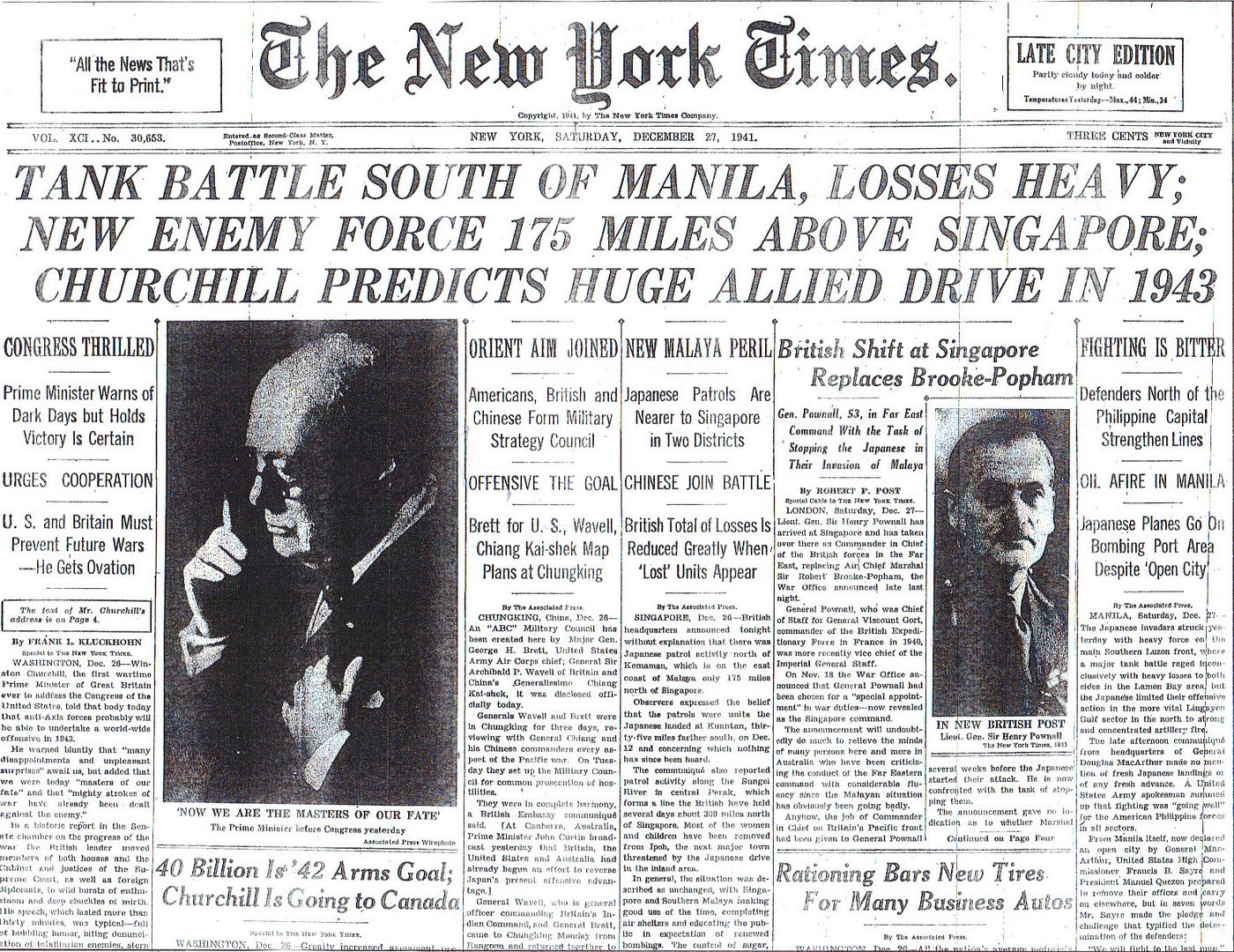
Posted on 12/27/2011 4:41:58 AM PST by Homer_J_Simpson

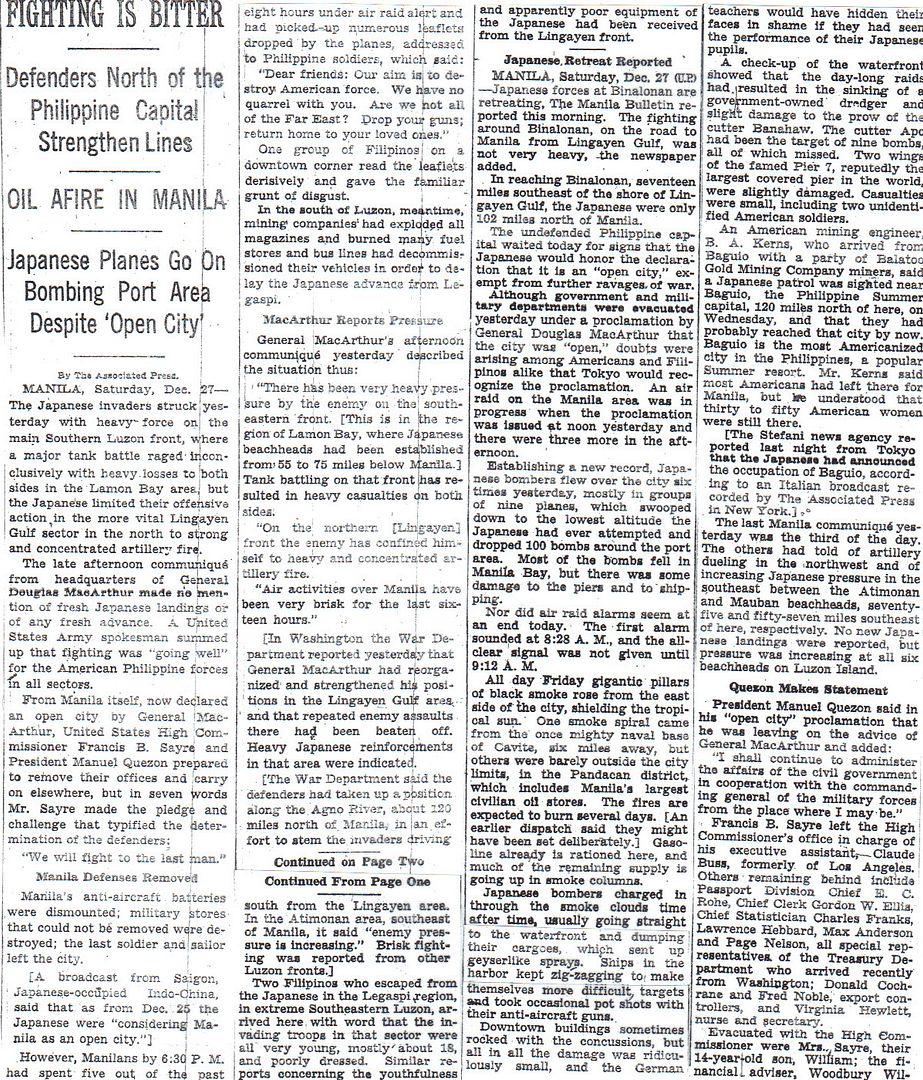
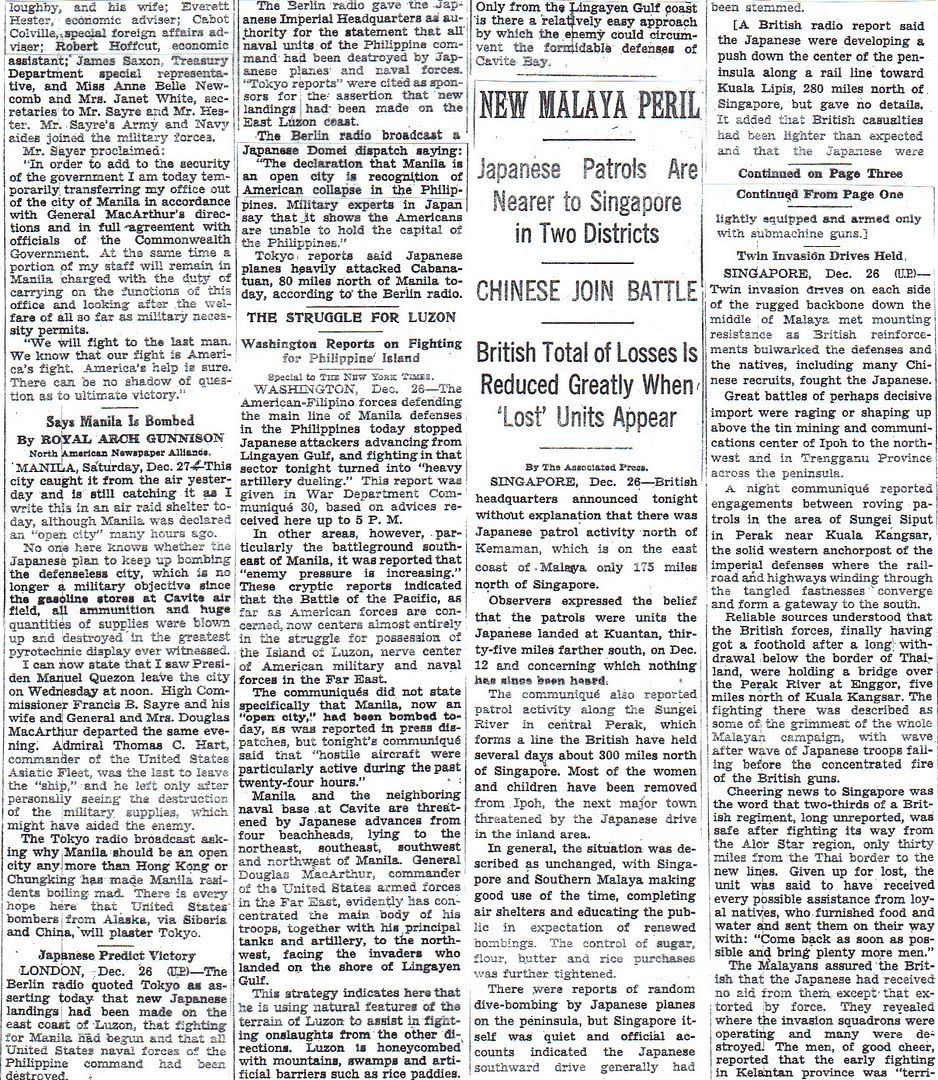

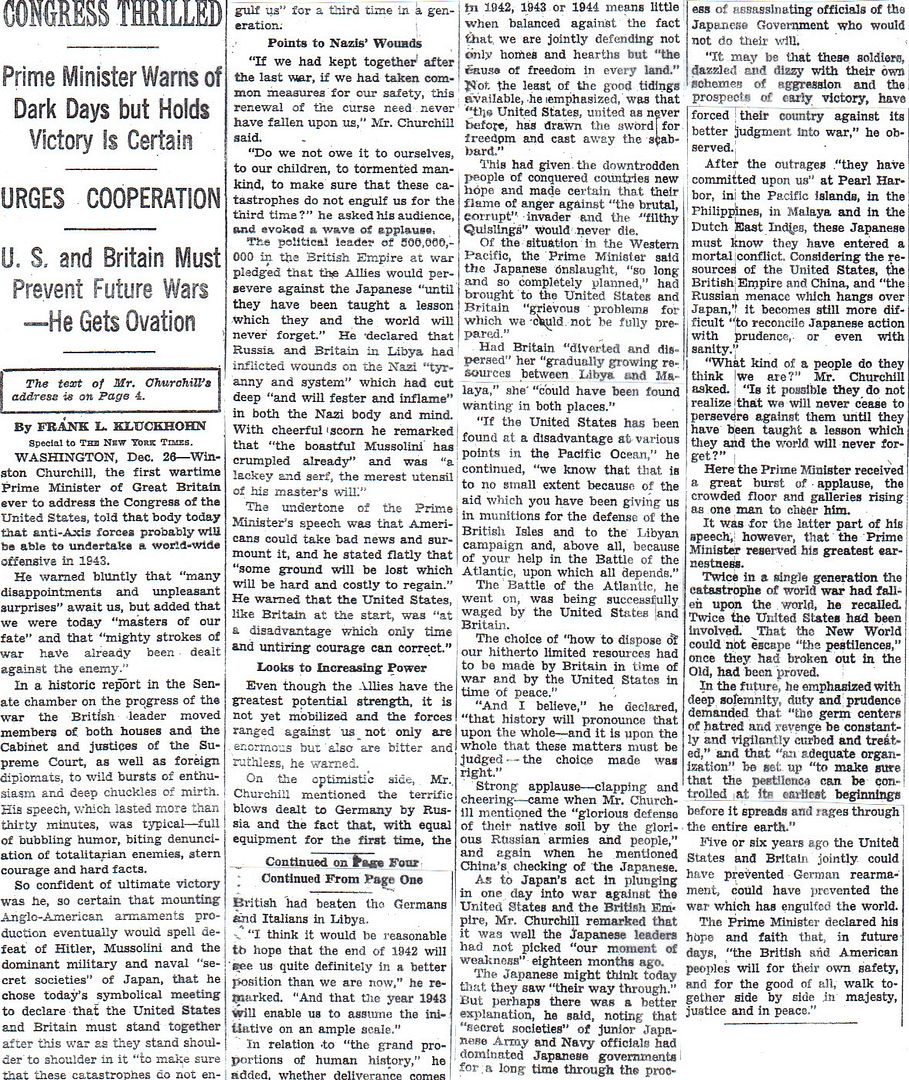
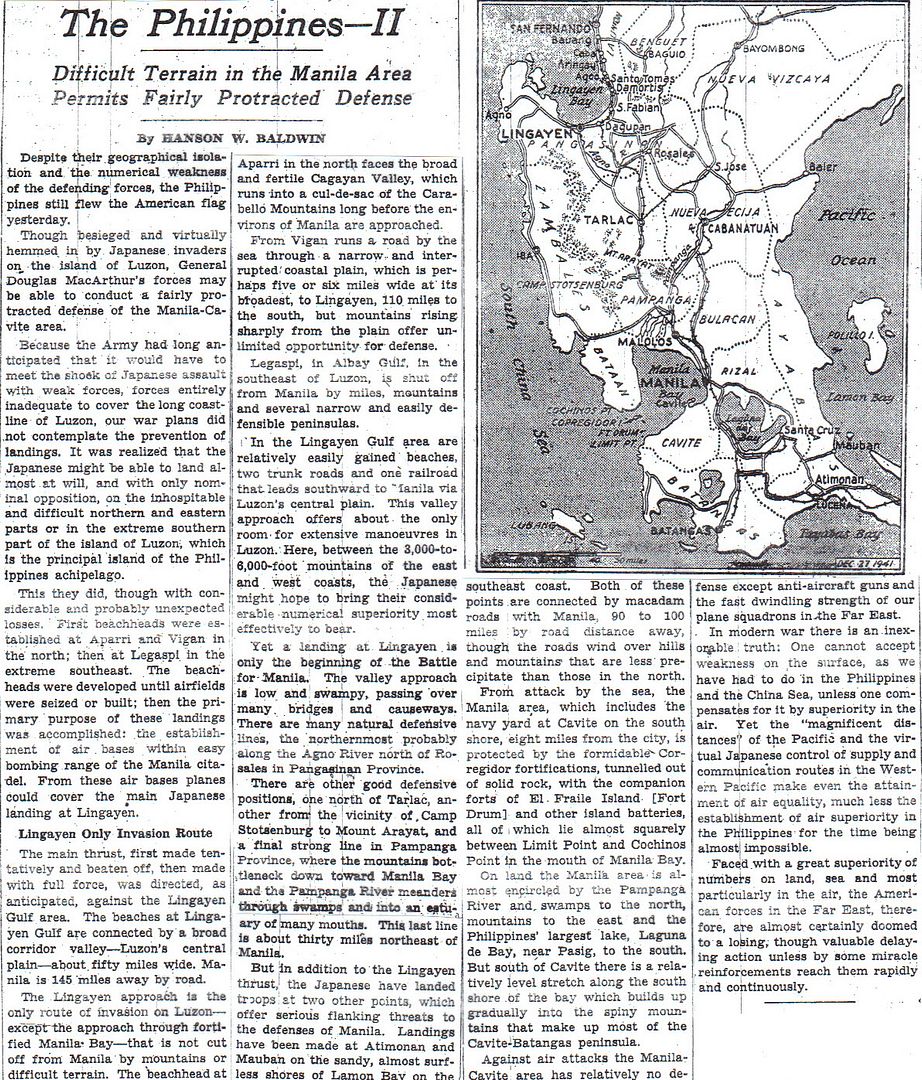
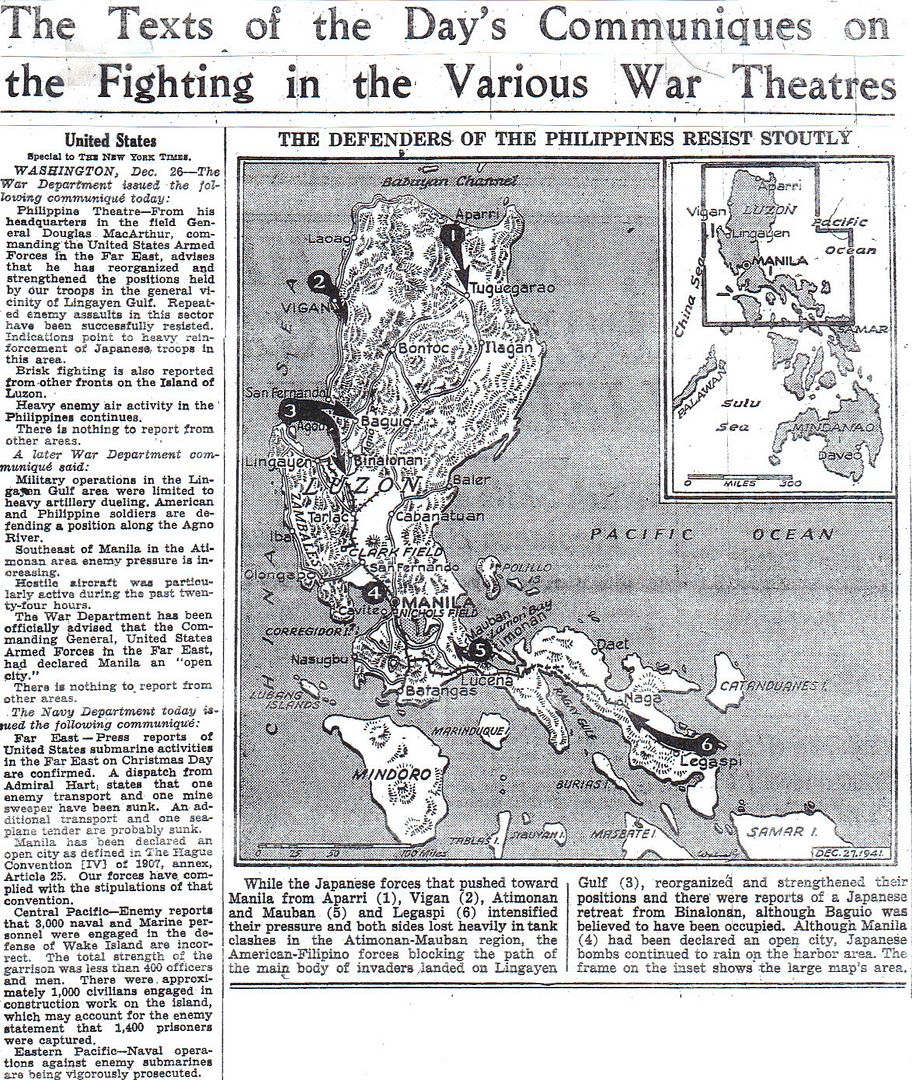

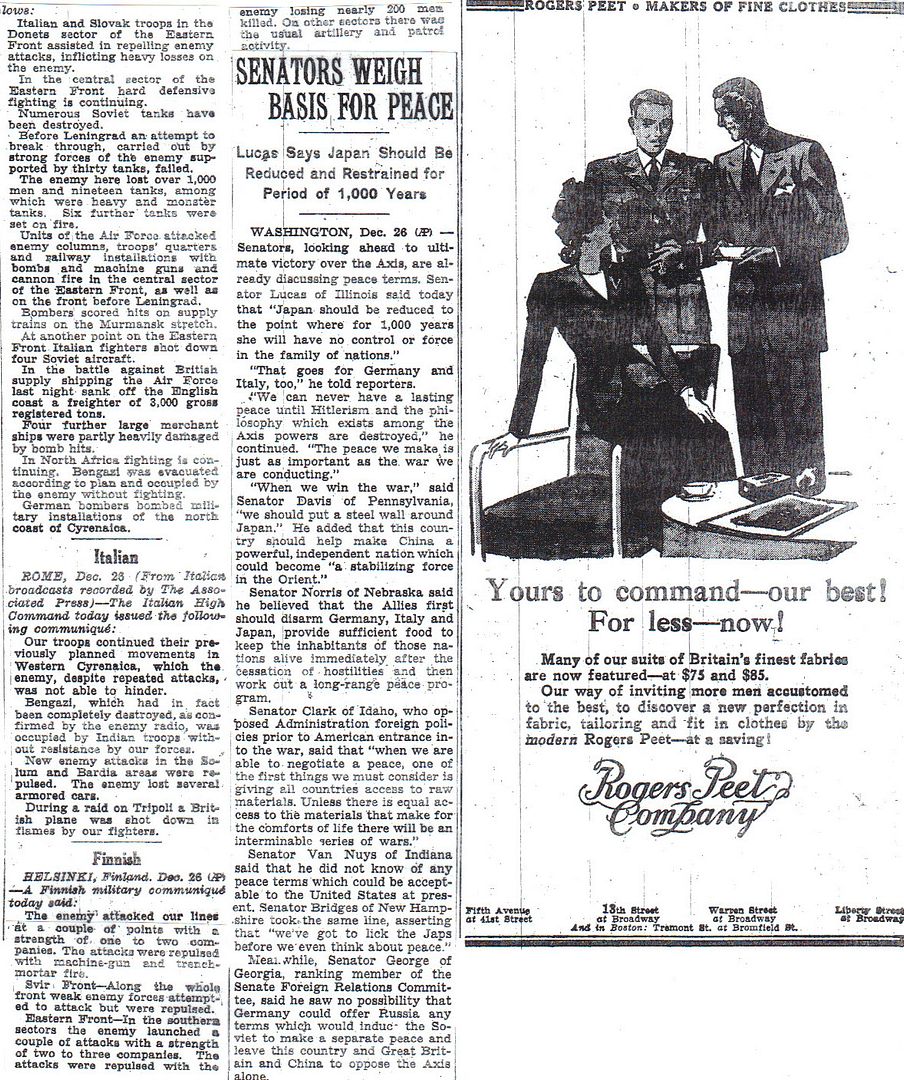
http://www.onwar.com/chrono/1941/dec41/f27dec41.htm
Americans declare Manila open city
Saturday, December 27, 1941 www.onwar.com
In the Philippines... The Americans declare Manila an open city. The defenders are now at their third of five lines of defense in their delaying action against the Japanese invasion of the Philippines. This line runs east and west from Paniqui.
In Occupied Norway... The British commando raids extend to Vaagso and Maaloy, landing nearly 600 troops to destroy communications and oil factories. Merchant and patrol craft are sunk. 243 volunteers are taken back to Britain to join Norwegian forces there.
From London... General Pownall replaces Air Marshall Brooke-Popham as Commander in Chief Far East. This command will shortly be assumed by Wavell’s ABDA under the provisions of the Arcadia Conference. Pownall will become its Chief of Staff.
http://homepage.ntlworld.com/andrew.etherington/month/thismonth/27.htm
December 27th, 1941
NORWAY: OPERATION ARCHERY: The British land 600 commandos on Vaagso and Maaloy in the Lofoten Islands. These landings are on the heels of the landing yesterday, on Moskenesoy. Their targets today will be a fish-oil factory and a radio station. These are dummy targets to mask the real intention: an Enigma machine and weather codes at the weather station, on the “Vorstenboote”, 200 ton trawler. The boat was machine-gunned to cut down the crew but not to sink it. Mission successful. (Adrian Weale, Denis Peck and Torstein)
It was not all plain sailing for the British force, however, stiff resistance from the German garrison meant house-to-house fighting for five hours. Navy guns silenced shore batteries while RAF Blenheims bombed the wooden runways of the nearest Luftwaffe base 100 miles away, closing the airfield. 19 men were killed, including Captain John Giles, the former heavyweight boxing champion from Bristol. Eight ships and eight aircraft were lost.
Around 100 Germans were killed and about the same number taken prisoner. At the same time 243 Norwegians have also come away with the force - but voluntarily. They are patriots who will be a welcome addition for the Norwegian Free Forces.
U.S.S.R.: Leningrad: Early today sounds of heavy firing are heard coming from the Intermediate position of the Spanish Division Azul. It is under attack by a Soviet force attempting to infiltrate to the rear of the sub-sector. At 6.30am Udarnik erupts in shell-fire, in the wake of which a Russian battalion manages to penetrate the village. Comandante Roman’s 2/269th drove the Russians out again and pursues them southwards. At the same time Comandante Rebull and three companies of the 1/269th are advancing northwards from Lubkovo. At 10.00am the two units meet at the Intermediate. They are horrified to discover on the snow covered promontory, scattered around the trenches and weapons-pits, the bodies of Alferez Moscoso and his men, stripped of their uniforms, mutilated and literally nailed to the ground with their own bayonets and with picks driven through their chests. (125) (Russ Folsom)
COMMONWEALTH OF THE PHILIPPINES: MacArthur declares Manila an open city. US forces have fallen back to their 3rd defence line which runs east and west from Paniqui.
INDIA: British General Pownall takes over from Air Marshal Brooke-Popham and British Commander in Chief Far East. Pownall will later become Chief of Staff to Wavell;s ABDA command.
http://www.combinedops.com/lofoten_2.htm
LOFOTEN ISLANDS 2nd RAID ~
26/27th DEC 1941
Operation Anklet, the second Lofoten Islands raid, was a diversion in support of a larger action at Vaagso further south on the Norwegian coast. There was no opposition to the landing, but a near miss from a German bomber convinced the planners that in future operations of this kind, air cover would be provided as a matter of routine.
Background
The Lofoten Islands lie off the Norwegian coast about 100 miles north of the Arctic Circle. In appearance and size they resemble the Outer Hebrides off the north west coast of Scotland. They were selected by Combined Operations HQ as a relative safe diversionary target to coincide with the main Vaagso raid some 300 miles south. [Photos courtesy of Capt OB ‘Mickey’ Rooney’s family; 1) Scapa Flow in the Orkney Islands, 2) En route to Norway.]
Planning & Preparation
Since the first Lofoten Raid in March 1941 the German forces in Norway had been strengthened including air cover (as Churchill had expected). Feints and major raids were now a legitimate tactic to divert attention, confuse the enemy and to promote the idea in the collective mind of the German High Command that Norway was a serious option for the launch of an invasion of mainland Europe from the UK. [Photos; 3) Cruiser Arethusa on escort duty to Norway, 4) Sorvagen Landed on Quay.]
Action
300 men from No 12 Commando and a number from the Royal Norwegian Army under the command of Lieutenant-Colonel S.S. Harrison landed at 06.00 hours on Boxing Day. The planners had timed the raid in the expectation that the German garrison would be caught off guard. This was especially likely after the Christmas festivities of the day before. [Photos; 5) Vorge Fjord, 6) Surveying craft sent from admiralty to pick up captured documents.]
The landings were unopposed as the men, wearing white hooded overalls, entered two harbours on the westerly island of Moskenesoy. The towns of Reine and Moskenes were soon occupied and a small number of German prisoners and quislings were taken including those manning the wireless station at Glaapen. A large supply of French chocolates and cigarettes was found and distributed to grateful locals. However there was concern about reprisals and many locals wanted the British forces to stay.
Admiral Hamilton on his Cruiser HMS Arethusa, with 8 destroyers in support, was tempted to consider a prolonged stay. There was after all no sunrise in these latitudes between the 10th December to 3rd January so the risk of attack from the air was much reduced. However a bomb dropped by a German seaplane on the 27th fell close to the cruiser so Harrison decided to withdraw having completed the mission successfully.
Outcome
Two radio transmitters were demolished, several small German boats captured and a few Germans and Quislings taken prisoner - and there was disruption of sea communications in the area. The raid had served its purpose and all men and equipment returned safely. However, this was the last time such a raid was undertaken without air support. The nature of this form of warfare was changing as both sides assimilated past experiences into future planning.
Summary of Action
Allied Forces: Sea - HMS Arethusa & 8 Destroyers. Land - 300 men from No 12 Commando.
Axis Forces: Land - Local German Garrison.
Outcome (Positive): A unopposed diversionary raid. Two radio transmitters demolished. Capture of several small German boats, Germans and Quislings.
Outcome (Negative): None.
Further Reading
The Vaagso Raid; The Commando Attack That Changed The Course of World War II by Joseph H. Devins.
Lofoten Museum’s page on the Lofoten 2nd Raid.
Commandos and Rangers of World War 2 by James D. Ladd. Published in 1978 by MacDonald & Jane’s. ISBN 0 356 08432 9
Commandos 1940 - 1946 by Charles Messenger. Published by William Kimber, London 1985. ISBN 0 7183 0553 1
The Watery Maze by Bernard Fergusson published 1961 by Collins.
http://www.combinedops.com/vaagso.htm
~ OPERATION ARCHERY ~
VAAGSO - 27TH DEC 1941
Operation Archery, the raid on Vaagso and Maaloy, broke new ground with the provision of air cover as an integral part of the raid in the initial planning process. The planners had learned from the 2nd Lofoten raid that the lack of air cover could put similar missions in jeopardy.
Background
The Islands of Vaagso and Maaloy lie on the Norwegian coast between Bergen and Trondheim. Until the raids of December 1941 these small islands were little known outside the immediate area. Churchill was keen to mount a major raid, ideally against Trondheim to take pressure off the Russians and to protect allied convoys to Murmansk, but this was not feasible in late 1941. A diversionary raid on the Lofoten Islands 300 miles to the north was mounted to coincide with Vaagso.
Planning & Preparation
Mountbatten was appointed to the post of Combined Operations Adviser in October 1941. He decided that a raid of sufficient size to tie down German troops in Norway, thus denying their use on the Russian front, would best meet Churchill’s aspirations. The target was selected because it also offered the chance to damage German military establishments on Vaagso and Maaloy.
This was not the first such planned operation. On December 9th No. 6 and half of No. 9 Commando, under the codename Operation Anklet, set off for the Norwegian town of Floss in the landing ship HMS Prince Charles. An accidental grenade explosion on board caused casualties amongst which were those skilled in navigation. With his navigational accuracy compromised the Senior Naval Officer called the raid off.
Rear Admiral H M Burroughs and Brigadier Charles Haydon were appointed on Dec 6 to be naval and military commanders of Operation Archery. At their disposal were No. 3 Commando, two troops of No. 2, a medical detachment from No. 4, a party of Royal Engineers from No 6 for demolition jobs and a Royal Norwegian Army detachment under the command of Major Linge ... in all around 51 officers and 525 other ranks. Colonel John Durnford-Slater, who had been involved in the detailed planning, was to be in charge of the landing party.
Many had served Haydon on the first Lofoten raid of the previous March but that was an undefended action. Vaagso was an entirely different proposition. There were German troops on both Islands and significant coastal defences to overcome. Intelligence sources indicated that 150 men from the 181st Division, a solitary tank and 100 construction workers were billeted in the town. Four squadrons of fighters and bombers totalling 37 planes were operating in the area from bases at Herdia, Stavanger and Trondheim. No enemy warships were thought to be in the area.
On the small island of Maaloy, less than 500 metres by 200 metres, there was a concentration of coastal defences, ammunition stores, oil tanks and a German barracks. In addition the island was well placed to guard South Vaagso town where there was an oil factory, several fish factories and a power station. Convoys were also known to assemble a few cables further up the fjord offering the possibility of another target.
By the 15th the raiding forces had been assembled and training exercises carried out. The flotilla comprising the Cruiser HMS Kenya fitted with 6-inch guns, four destroyers and two landing craft, HMS Prince Leopold and HMS Prince Charles, left Scapa Flow in the Orkney Islands on Christmas eve. They diverted to Sullom Voe in the Shetlands because of atrocious westerly gales severe enough to cause damage. Prince Charles took onboard 145 tons of water which had to be pumped out. Other damage was repaired and the men were given the chance to enjoy there Christmas dinner in relative comfort before they sailed again on the evening of the 26th.
The Raid
The next morning they rendezvoused at 07.00 hours with the submarine HMS Tuna on station at Vaagsfjord as their navigational check. Landing craft (LSIs) were kept out of view of the main batteries on Malloy. Fire was opened on the coastal defences by the warships at 08.48 hours, initially with a salvo of star shells from the Kenya to light up the island and then with 500 shells fired in 10 minutes from all five war ships. A low flying attack by Hampdens of RAF Bomber Command followed dropping smoke bombs to obscure the path of the advancing troops as they landed on the beaches. All the while air cover to ward of the Luftwaffe was provided by Beaufighters and Blenheims making round trips of 650 kilometres from Wick on the Scottish mainland or 400 kilometres from Shetland.
The Commandos were split into 5 groups. The 1st landed at Hollevik about 2 kilometres south of South Vaagso to knock out a German stronghold there. The 2nd landed just south of the town itself. The 3rd landed on Maaloy Island to mop up after the bombardment. The 4th was held as a floating reserve and the 5th Group was passed Maaloy into Ulvesund on the destroyer HMS Oribi. They landed to the north of South Vaagso to prevent German reinforcements getting through.
The German’s were taken by surprise but fought back bravely. Three of the four coastal guns on Maaloy were knocked out. The fighting there was over in 20 minutes due in part to the accuracy and precise duration of the naval action. Kenya’s bombardment lifted when the 105 men of group 3 were just 50 metres from the beach. The Germans barely had time to lift their heads before they were overrun. However in the action Linge was killed. The German survivors were rounded up, demolition work completed and the party crossed the short stretch of water to join the free for all going on in South Vaagso. Meantime the force at Hollevik experienced less resistance than expected since 8 defenders were in South Vaagso having breakfast. The Commandos were soon able to reinforce the South Vaagso skirmish. The floating reserve was also committed since German resistance was greater than expected. It later transpired that 50 crack troops were on Christmas leave in the town at the time.
In the meantime No 5 group were taken farther up the fjord past Malloy by the destroyer HMS Oribis accompanied by HMS Onslow. The men were landed without opposition and blew craters in the road to block reinforcements from getting through from North Vaagso. They also destroyed the telephone exchange at Rodberg. A number of merchant ships came into view as well as an armed trawler the Fohn and R.E. Fritzen. Those under power beached themselves when they saw the White Ensign flying. The Fohn and the Fritzen were boarded under sniper fire from the shore in the hope of finding confidential papers or secret code books. Around this time two ME 109s and two JU 88s were active in the area. No 5 group later joined the fighting in South Vaagso.
Resistance was not completely overcome in the street fighting but all the major demolition jobs were accomplished including the power station, coastal defences, the wireless station, factories and lighthouse. 150 Germans were killed, 98 Germans and 4 Quislings made prisoner and 71 Norwegians took passage back to England. Farther up the fjord the destroyers sank 9 ships totalling 15,000 tons and in the air four Heinkels were shot down. Both Herdia and Stavanger airports were bombed, the wooden runway of the former suffering sufficient damage to limit activity.
There were many instances of bravery on both sides in the taking and defending of entrenched positions. At 13.45 hours Colonel Durnford-Slater ordered the withdrawal from South Vaagso to begin. It was led by No.2 troop, followed by No. 6 with No 1 in rearguard. The force re-embarked at 14.45 hours as the short arctic day drew to a close. Allied losses were 70 Commando casualties including 17 killed and 8 Navy casualties including two killed. In addition two Beaufighters and a Blenheim (Hampden?) were lost.
Each Commando unit had a Medical Officer and a number of medical orderlies attached to it as first line support. On the Vaagso raid they all carried a haversack containing basic medical supplies such as shell dressings, bandages, morphia and water. They were relatively lucky compared to the airborne forces in that reasonable medical facilities were available on the ships that transported them to and from their objectives.
The Outcome
This was the first time all three services combined their resources to mount an amphibious raid against a defended coast. As Mountbatten said at the outset “... nobody knows quite what is going to happen and you are the ones who are going to find out.” The RAF provided air cover for over 7 hours and undertook diversionary raids elsewhere. None of the British ships was hit by enemy bombs but a phosphorous bomb from a disabled British plane hit one of the landing craft resulting in some casualties.
Much had been learned by both sides. Later the Germans over-stretched their Atlantic wall with the deployment of 30,000 extra troops to reinforce the Norwegian sector. Clearly Hitler had taken the bait that Norway might well be “the zone of destiny in this war.” The Press Unit had been very active during the raid and some of the most graphic and dramatic photographs in WW2 were taken. These and eye witness reports were later used for morale boosting purposes at a time in the war when there was little good news to cheer about.
The future pattern of sizeable raids and landings had been set.
Summary of Action
Allied Forces: Air- Bomber Command and Coastal Command; Sea - Cruiser H.M.S. Kenya, Landing Ships H.M.S. Leopold and Prince Charles, Submarine H.M.S. Tuna plus four destroyers; Land - No 3 Commando, two troops of No 2 Commando, a medical detachment from No. 4 Commando and demolition experts from No. 6 Commando, a Royal Norwegian Army Detachment.
Axis Forces: Air - Luftwaffe Heinkels, ME 109s and JU 88s. Land - 150 men from 181 Division, 50 troops on leave in the area.
Outcome (positive) - successful destruction of coastal defences, oil and fish factories, radio transmitters, stores, a lighthouse, a power station, 9 merchant ships totalling 15,000 tons and four Heinkels. 30,000 additional German troops deployed to the Norwegian sector taken from other fronts but notably the Atlantic Wall. 150 Germans killed, 98 captured and 71 Norwegians took passage to the UK.
Outcome (negative) - Commandos: 2 Officers and 15 OR killed, 5 Officers and 48 OR wounded, Norwegians: 1 Officer killed and 2 OR wounded, Royal Navy 2 OR killed and 2 Officers and 4 OR wounded and RAF 31 killed (2 Hampden’s, 7 Blenhiem’s and 2 Beaufighters were lost).
The Army, Norwegian and Naval casualties come from PRO document DEFE 2/83. The RAF casualties come from DEFE 2/83 (for the Coastal Command losses) and Bomber Command losses 1941, W.R. Chorley, Midland Publishing (for the Bomber Command losses).
Veterans Return in 2005
OPERATION ARCHERY VETERANS
I attach a photograph of the 7 veterans who attended a commemorative trip to Vaagso and Maaloy in 2005. The esteem in which they were held by the local people was heart-warming to see.
The veterans met up in Bergen and travelled to Maaloy on a WWII gun boat - the fully restored “HITRA” given to the Norwegian Navy by the USA. Whilst in Maaloy they were treated like royalty, attending many functions and parades, also laying a wreath on the grave of the only civilian killed on the raid. They were presented with plaques and a painting by the Norwegian Chief of Defence and the Mayor of Vaagso.
The trip was funded by the National Lottery Returning Heroes Fund.
Howard P Habron
Further Reading
There are over 200 books listed on our ‘Combined Operations Books’ page which can be purchased on-line from the Advanced Book Exchange (ABE) whose search banner checks the shelves of thousands of book shops world-wide. Type in or copy and paste the title of your choice or use the keyword box for book suggestions. There’s no obligation to buy, no registration and no passwords. Just click on the book icon opposite to take you to the ABE banner.
List of Commando operations in Norway
The Vaagso Raid by Joseph Devins Jr. Published by Robert Hale 1967.
Storm from the Sea by Lt Col Peter Young. Published by William Kimber 1958.
In Harms Way by Brian Crabb. Published 1998. The story of HMS Kenya from her build to break up including a chapter on the Vaagso raid. Hardback with a full-colour cover, 250 pages. ISBN 1 900289 02 4
Commandos and Rangers of World War 2 by James D. Ladd. Published in 1978 by MacDonald & Jane’s. ISBN 0 356 08432 9
Commandos 1940 - 1946 by Charles Messenger. Published by William Kimber, London 1985. ISBN 0 7183 0553 1
Commando by John Dunford-Slater. Published by Kimber 1953 - from the pen of one of the major players.
The Watery Maze by Bernard Fergusson published 1961 by Collins.
http://www.whha.org/whha_shows/eleanor_roosevelt/14_my-day-b.html
My Day” by Eleanor Roosevelt
December 27, 1941
WASHINGTON, Friday—Last night we had a rather large gathering of various family groups at Christmas dinner. The number of cousins was really quite amusing. I think the complications of family relationships, as regards my husband and myself, became completely baffling to our English guests. I tried to explain to Lord Beaverbrook, what relation my husband is to Mrs. Theodore Douglas Robinson, and I think at the end he was as mystified as if I had never attempted an explanation!
When you tell some one, that the lovely lady sitting opposite him is your husband’s half-niece, that she married your first cousin, and that he was her sixth cousin, whereas you are married to your fifth cousin once removed, and are also her sixth cousin and that her children, in order to simplify life, say “Uncle Franklin and Auntie Eleanor,” when the relationship is really only that of a half great—uncle; you may well imagine that you have led anyone, no matter how great his interest in genealogy through a maze from which there is no emerging!
Field Marshal Sir John Dill, celebrated his birthday as well as Christmas here last night. I wish I had known sooner, for I would certainly have provided him with a birthday cake.
A few old friends were here with us as usual, and we drank the usual toasts to absent family and friends, adding one toast in tribute to our British guests. After dinner, we had newsreels, featuring both the Prime Minister and the President, and then sang some Christmas carols together before saying goodnight and letting the President, the Prime Minister and Lord Beaverbrook go back to work again.
I was a little late at the office this morning on purpose. My office force, however, was all there ahead of me. So many people left Washington for the weekend, that there was comparatively little to do.
After clearing up the mail and seeing one or two members of the staff, I listened on the radio to the Prime Minister’s speech in the Senate, and then came home to a late luncheon. I am planning to devote the afternoon to telling some of the kind people who sent me Christmas gifts how much I am enjoying them.
It will be quite impossible for me, of course, to thank the many people who have sent the President and me Christmas cards and telegrams, but I want to say here how grateful we are for their thoughts & the confidence and affection which so many of them expressed.
E.R.
Tanks..... Tanks a lot!
Disclaimer: Opinions posted on Free Republic are those of the individual posters and do not necessarily represent the opinion of Free Republic or its management. All materials posted herein are protected by copyright law and the exemption for fair use of copyrighted works.